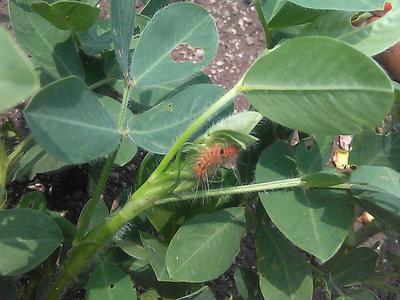Red Hairy Caterpillar
Amsacta albistriga
Insect
In a Nutshell
- Larvae feed extensively on buds, leaves, stems and other plant parts.
- Discoloration and shedding of leaves.
- Defoliation of plants.
- Severe yield losses.
- Mature larvae are reddish-brown with a black band and long reddish hairs on the body.
Can also be found in
Symptoms
Young caterpillars appear in large numbers during the rainy season and scarp the lower surface of the leaf. Mature caterpillars feed voraciously on all plant parts, including flowers, buds, and leaves. Only hard tissues such as the midrib, the veins and the petioles are left. The grown up red hairy caterpillars move in clusters from field to field, often causing severe defoliation and yield reduction in the whole area. Full grown larvae burrow into the soil to pupate, usually in undisturbed soils.
Recommendations

Organic Control
Biocontrol methods include the release of Trichogramma parasitoid wasps. These parasitize on eggs and young larvae of the red hairy caterpillar. Spraying bio-insecticides based on Nuclear Polyhedrosis Virus (NPV) or Bacillus thuringiensis in early stages can effectively manage the pest.

Chemical Control
Use an integrated approach with preventive measures and biological treatments to control populations of red hairy caterpillar. If the economic threshold for chemical treatment is reached (eight egg masses per 100m length or 10% leaf damage), dusting of insecticides might control young larvae. Other insecticides may also be used to control full grown insects.
What caused it?
The adult moth emerges from the soil immediately after the monsoon rain. It has light brown forewings with white streaks over the pane and a yellowish band along the anterior margin. Its hindwings are white with distinct black spotson them. Females lay about 1000 creamy yellow eggs in clusters on the underside of leaves, or on soil debris. The light-brown young larvae are hairless and feed gregariously on leaves. Mature larvae are reddish brown with a black band on their flank and long reddish hairs on the body. They are highly active and destructive. They burrow 10 to 20 cm into the soil under trees, hedges, or shady corners and remain there as pupae for about 10 months before emerging again as adults.
Preventive Measures
- Sow early to avoid peaks in insect populations.
- Avoid migration of larvae by digging a trench of 30 cm in depth and 25 cm in width.
- Intercrop with castor oil plant for every 6 rows of groundnut.
- Use light traps to monitor or mass-catch the moth.
- Crop rotation with sorghum, pearl millet or maize should be followed.
- Irrigate once to avoid prolonged mid season drought and prevent pre-harvest infestation.
- Check for alternative hosts and weeds and remove them.
- Monitor, collect and destroy eggs and gregarious larvae on leaves of crops and intercrops.
- Deep plow to expose pupae to environment and predators.



